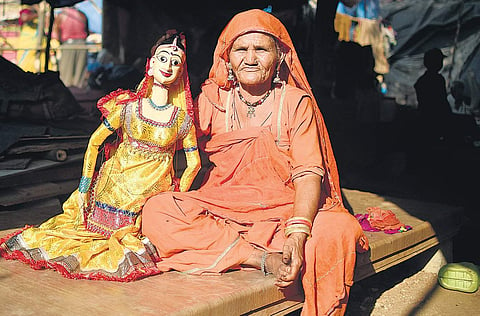

HYDERABAD: The tinny sound of an on old Bollywood number mixes with the raucous shouts of children. If you listen carefully, there is another sound that’s lost in the din – that of scrapping wood. In a squalid corner in one of the poshest areas of the city, a group of artisans from Rajasthan carve out colourful puppets that belie the darkness of the huts they are made in.
“We have been here for the past five-six years, and during that period, we managed to get only six shows. We get Rs 4,000 – Rs 5,000 per show,” says Pintu, one of the motley bunch of Rajasthani folk artistes and artisans that have made a roadside in Hi-Tec City their home. The rest of their income comes from selling toy horses and home decorations.
They stay close to Shilparamam, the Telangana government’s arts, crafts and culture Rs l village. They would like to have a stall there, but cannot afford the cost.
“We came here from Nagaur district of Rajasthan. Our ancestors have been into puppetry for centuries. They started out at a time where there used to Rajas and Maharajas. The only forms of entertainment then were Ram Lila and puppet play. The know-how of this art form has been passed to us through many generations, but the interest has waned now. We came here because we could not survive the competition in our home district,” continued Pintu.
“The demand is seasonal,” says another from the group. “It increases around the festive season. During the rest of the year, we get calls to perform in schools and weddings. We tell them stories about Shivaji Maharaj, Maharana Pratap and Amar Singh Rathore. But children nowadays are not interested in these stories. So we make the puppets dance to popular Bollywood songs. In weddings, we play Punjabi dhol.”
Play, props and people
Pintu takes a break and goes to fetch a puppet to show us. A man sits on the ground in a corner, carving out the face of a puppet from a block of wood. The rest of the puppet is made from hay and clothes. They also carve other wood figurines which they sell outside Shilparamam for `4,000-`5,000 a piece. “If we sell them at a stall, we will get double the rate,” he says.
Another group of men, sitting by a pile of empty teacups, makes toy horses. The colour of the horses do not conform to their natural form and are orange, pink and purple. The craftsmen ’s nimble fingers first make the wooden frame, stack hay on it and then cover the body with cloth. They then sew in the eyes, the ears, the hooves, the tiny details. “A small horse sells for Rs 250, and the bigger ones for Rs 400,” they say.
Just when you begin wondering in what other art forms these members are well-versed in, Hansaji attracts our attention with colourful decorations made of tiny elephants, mirrors, birds, beads and everything gay. “These are used to decorate doors and other places. These elephants are made of lac which we buy from traders in Rajasthan and Gujarat. We make the birds ourselves,” said the ruddy-faced woman, the afternoon sun deepening the blush on her cheeks.
Hansaji’s mother, the 75-year-old Kamal, sits on a charpoy and nods in agreement to what her daughter says. Incredibly beautiful and dressed in an orange traditional Rajasthani attire and jewellery, Kamal says: “We have a daily show at Shilparamam at 3 pm. I tell tales of shehzadas and Rajas of bygone era. The story of Amar Singh Rathode is my favourite. With whatever I get from the shows, I have to feed the eight members of my family.”
Her husband Sohanlal, the 81-year-old patriarch of the clan, recounts his journey in Hyderabad: “I have been visiting this city from 1958. I fell in love with the city and decided to stay back 12 years ago. I frequently make trips to Rajasthan and have performed all over India. I take part in the Shilparamam shows and teach the young ones our trade. Nobody should sit idle.”
When asked if the children go to school, one of the fathers replied: “We are nomads. We keep roaming from place to place. How will the children go to school?”
The performance
Pintu comes back with Anarkali – a puppet dressed in traditional Rajasthani outfit the colour of sunshine. Jeetu is ready in a peacock blue kurta and dhoti. Pintu ties a yellow Bandhani safa around his head.
To the beats of drums and the song Pallo Latke from Sanjeev Kumar’s Naukar, Anarkali comes to life, her hips moving in bursts of energy. Jeetu pulls the strings with dexterity as Anarkali moves her hands, twirls and catches the light in the tiny mirrors of her ghaghra.
Do they get many requests to perform songs from Mughal-e-Azam with Anarkali? “No,” they say. “The song Anarkali Disco Chali is more popular.”
Yes. Of course.
If you want to book a puppet show or help out these talented artistes, please contact Vinod Bhatt (9958547588) or Sunil Bhatt (9871326341).